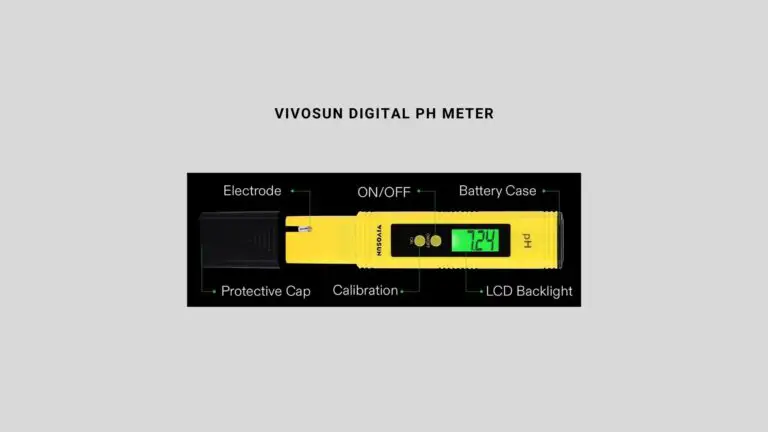How to Use Grow Lights for Indoor Seedlings: Tips and Tricks
Disclosure: Your purchases through our links may earn us a small commission, supporting our site’s ability to provide valuable information to our readers. Rest assured, it won’t impact your price. Thank you for your support.
Whether you’re a seasoned gardener or starting, you know the importance of seedlings. And if you want to get your garden off to a successful start, using grow lights is useful. But how do you use grow lights for indoor seedlings? Keep reading for tips and tricks on how to use grow lights effectively.
What Do Grow Lights Do for Seedlings?
Grow lights provide the necessary light spectrum for seedlings to grow. They mimic the natural sunlight that seedlings need to grow strong and healthy. Without grow lights, your seedlings may not grow as well or may not grow at all. Please read grow Light vs. Sunlight and grow light vs. regular lights to understand the difference between them.
There are different types of grow lights available on the market. You can choose from fluorescent, LED, or HID grow lights. Each type has its own set of benefits and drawbacks. For example, fluorescent grow lights are cheaper than LED grow lights but don’t last as long. On the other hand, LED grow lights are more expensive but last longer and use less energy.
To determine which grow light is best for you, it’s important to consider your needs and budget.
Related: The Top 11 Things to Know Before Buying a Grow Light
The Benefits of Using Grow Lights for Seedlings
There are several benefits to using grow lights for seedlings. grow lights can:
- Help seedlings grow faster
- Give seedlings the light they need to grow strong and healthy
- Make it easier to grow plants indoors
Using grow lights is a great option if you’re looking for a way to help your seedlings grow faster and healthier.
Indoor grow lights can also be used to grow hydroponic plants. Hydroponic plants are grown in water instead of soil. Using grow lights to grow hydroponic plants is a great way to save space and get a high yield.
Related: 6 Amazing Benefits of Grow Lights for Your Indoor Hydroponic Garden
How to Set Up Your Grow Light System
Once you’ve decided on a grow light, setting it up is easy. Most grow lights come with instructions on how to set them up.
- When setting up your grow light system, it’s important to ensure that the grow light is the right size for your seedlings.
- Also, you want to ensure that the grow light is close enough to the plants to absorb the light but not too close that they are burned or damaged. You can read our article on the proper distance to set up grow light and learn more.
- Most grow lights come with a stand or a mounting bracket that you can use to attach the grow light. If your grow light doesn’t come with a stand or bracket, you can purchase one stand or a mounting bracket separately through Amazon.
- Once you have your grow light set up, you need to decide what light schedule you want to use. There are several light schedules: continuous light, 16-hour day, 12-hour day, 8-hour day, and 4-hour day. Continuous light means that the grow light is on all the time. This is the most common type of light schedule, and it’s best for plants that need a lot of light.
- Once you’ve decided on a light schedule, you need to determine how long you want to leave the grow light ‘ON’ each day. Most grow lights come with a timer, so you can easily set it. If not, you can purchase timers specially made for lighting.
Related:
Does Grow Light Temperature Matter?
Do Grow Light Colors Matter? The Surprising Science of Plant Lighting
Tips and Tricks for Using Grow Lights for Seedlings
Assuming you’ve already bought your grow light and set it up, there are a few things to remember when using grow lights for seedlings.
- Make sure that your grow light is positioned correctly
- Make sure that the grow light is facing the plants or seedlings
- Make sure to keep an eye on your plants and adjust the distance between the grow light and the plants as needed. This will ensure that the seedlings receive enough light without being damaged by the growth light’s heat.
- Make sure to change your grow lights every 6-12 months in general. But this period differs with the grow light type and manufacturer. So read their instructions carefully. This is because grow lights deteriorate over time and need to be replaced to provide the best possible light for your seedlings.
- Use a timer to turn your grow lights on and off automatically. This will give the seedlings enough light to grow without being over-exposed. Also, your seedlings receive the right amount of light each day without you forgetting to turn the grow lights on and off.
- Monitor your seedlings regularly and adjust the watering and fertilizing as needed. This will help keep your seedlings healthy and happy under the grow lights.
These tips will help you get the most out of your grow light system and ensure that your seedlings grow healthy and strong. Also, you should be able to solve any problems you’re having with your grow light system.

Thank you for reading!
You may also want to buy Grow room glasses, Grow tent, Grow tent kit, LED Grow lights, Grow room ventilation system, and PH-TDS-EC-Temperature digital meters. Click the links to select the suitable one for your hydroponic system.
Also, read:
8 Must-Have Hydroponic Growing Supplies for a Successful Indoor Garden
How to Overcome the Drawbacks of Grow Lights
11 Steps to Choosing the Right Fan for your Hydroponic Grow Rooms





